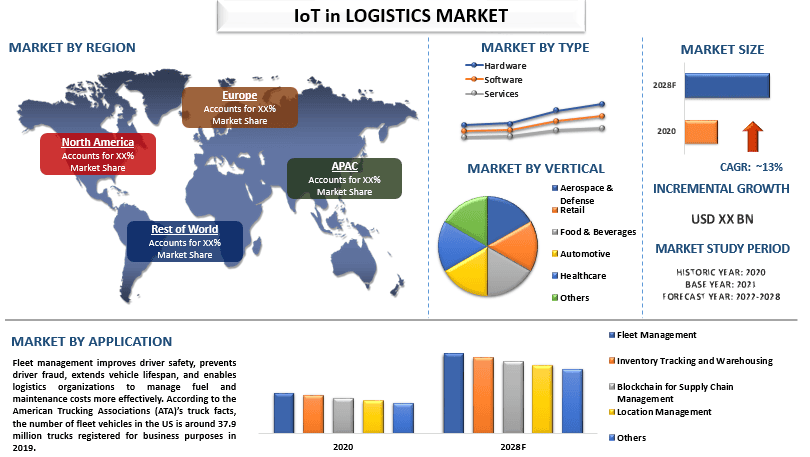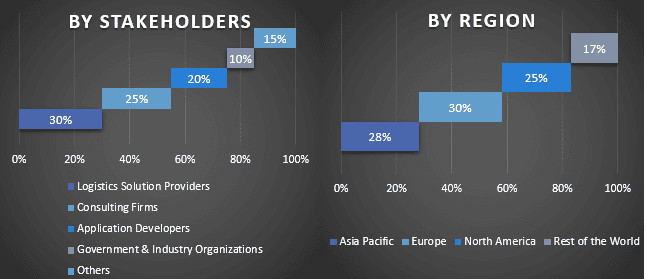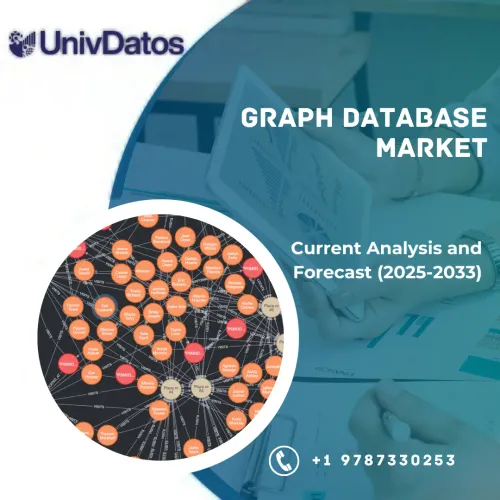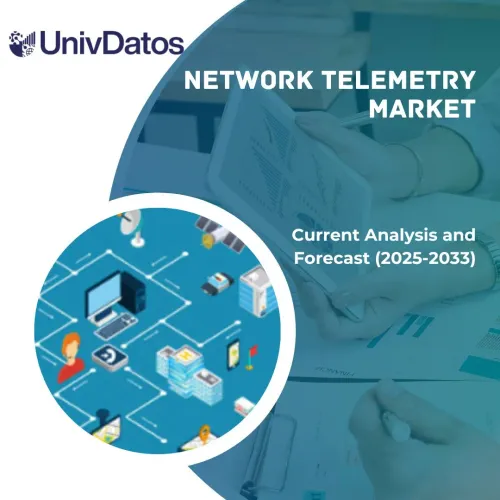- Home
- About Us
- Industry
- Services
- Reading
- Contact Us
IoT in Logistics Market: Current Analysis and Forecast (2022-2028)
Emphasis on Type (Hardware, Software, Services); Application (Fleet Management, Inventory Tracking & Warehousing, Blockchain Supply Chain Management, Location Management, Others); Verticals (Aerospace & Defense, Retail, Food & Beverages, Automotive, Healthcare, Others); Organization Type (Small and Medium Enterprise (SME), Large Enterprise); and Region/Country

Global IoT in logistics Market is expected to grow at a significant rate of around 13% during the forecast period. An IoT in logistics is growing rapidly due to the proliferation of wireless technologies, expanding e-commerce industry around the world coupled with the increase in the demand for more-efficient logistics operations. Moreover, the emergence of advanced technology solutions such as drones, robots, and self-driving cars has increased the demand for advanced wireless communication solutions. Furthermore, IoT hardware such as RFID chips, sensors and chipsets are becoming more affordable and delivery efficient results, thus, driving the market growth. For instance, In May 2021, Amazon expanded its logistics integration, intending to reshape the future of the industry. According to the company, it plans to invest an additional 80% of its capital in logistics-related operations, including investments for its fleets of vans, pilots, and trucks, as well as for its warehouses, with the aim of becoming its own end-to-end logistics operator, which could turn out to be an enormous coup for both private courier companies and national mail services across a number of countries.
Amazon.com Inc., IBM Corporation, Intel Corporation, AT&T Inc., PTC Inc., Hexagon A, Eurotech S.p.A., Cisco System Inc., SAP SE, Honeywell International Inc. are some of the key players in the market. Several M&As along with partnerships have been undertaken by these players to facilitate customers with hi-tech and innovative products/technologies.
Insights Presented in the Report
“Amongst type, services category to witness significant CAGR during the forecast period”
Based on type, the market is segmented into hardware, software, and services. Services category to witness significant CAGR during the forecast period. Marketplace services are aimed at enabling intelligent and coordinated decision-making processes and using efficient tools and techniques to mitigate the risks and vulnerabilities of the Internet of Things (IoT) in logistics. Additionally, these services enhance data management techniques and help meet the end-to-end needs of any industry.
“Amongst application, the fleet management to hold a significant share in the market in 2020”
On the basis of application, the market is categorized into fleet management, inventory tracking & warehousing, blockchain for supply chain management, location management, and others. Among these, fleet management to hold a significant share in the market in 2020. This is mainly due to it provides real-time fleet visibility. In addition, Fleet management improves driver safety, prevents driver fraud, extends vehicle lifespan, and enables logistics organizations to manage fuel and maintenance costs more effectively.
“Amongst verticals, the retail to hold a significant share in the market in 2020”
Based on verticals, the market is segmented into aerospace & defense, retail, food & beverages, automotive, healthcare, and others. The retail category to witness significant CAGR during the forecast period. With the use of IoT as a component of both retail management and warehouse technology, shrinkage, and inventory tracking will be reduced, and warehouse automation will provide multiple benefits. For instance, in September 2022, Honeywell and Internet of Things Technologies Company (IoT-squared), signed a Memorandum of Understanding (MoU) that aims to advance the fields of sustainable cities, logistics platforms and technologies that drive digitalization in Saudi Arabia
“APAC to hold a significant share in the market”
In 2020, APAC held a significant share of the global ATV market. This is mainly due to the swift urbanization and changing consumer behavior, majorly in India and China are driving the growth of the market. Moreover, IoT devices are also getting smaller, more affordable, and more potent, which makes them more customer-engaging and, consequently, more in demand in the area. The APAC region is expected to see an increase in the deployment of IoT solutions in the logistics industry as a result of these technical breakthroughs and expanding logistics activity. For instance, in September 2021, the Indian government approved a PLI scheme worth USD 3.5 billion for the auto industry and drone industry to boost India’s manufacturing capabilities. Moreover, proliferation of retail and logistics companies in many developing nations, along with the advancement of technology, has created a demand for IoT in logistics industry.
Reasons to buy this report:
- The study includes market sizing and forecasting analysis validated by authenticated key industry experts.
- The report presents a quick review of overall industry performance at one glance.
- The report covers an in-depth analysis of prominent industry peers with a primary focus on key business financials, product portfolio, expansion strategies, and recent developments.
- Detailed examination of drivers, restraints, key trends, and opportunities prevailing in the industry.
- The study comprehensively covers the market across different segments.
- Deep dive regional level analysis of the industry.
Customization Options:
The global IoT in logistics market can further be customized as per the requirement or any other market segment. Besides this, UMI understands that you may have your own business needs, hence feel free to connect with us to get a report that completely suits your requirements.
Table of Content
Research Methodology for the IoT in Logistics Market Analysis (2022-2028)
Analyzing the historical market, estimating the current market, and forecasting the future market of the global IoT in logistics market were the three major steps undertaken to create and analyze the adoption of IoT in logistics in major regions globally. Exhaustive secondary research was conducted to collect the historical market numbers and estimate the current market size. Secondly, to validate these insights, numerous findings and assumptions were taken into consideration. Moreover, exhaustive primary interviews were also conducted, with industry experts across the value chain of the global IoT in logistics market. Post assumption and validation of market numbers through primary interviews, we employed a top-down/bottom-up approach to forecasting the complete market size. Thereafter, market breakdown and data triangulation methods were adopted to estimate and analyze the market size of segments and sub-segments of the industry pertains to. Detailed methodology is explained below:
Analysis of Historical Market Size
Step 1: In-Depth Study of Secondary Sources:
Detail secondary study was conducted to obtain the historical market size of the IoT in logistics market through company internal sources such as annual reports & financial statements, performance presentations, press releases, etc., and external sources including journals, news & articles, government publications, competitor publications, sector reports, third-party database, and other credible publications.
Step 2: Market Segmentation:
After obtaining the historical market size of the IoT in logistics market, we conducted a detailed secondary analysis to gather historical market insights and share for different segments & sub-segments for major regions. Major segments are included in the report as type, application, verticals, organization type. Further country-level analyses were conducted to evaluate the overall adoption of testing models in that region.
Step 3: Factor Analysis:
After acquiring the historical market size of different segments and sub-segments, we conducted a detailed factor analysis to estimate the current market size of the IoT in logistics market. Further, we conducted factor analysis using dependent and independent variables such as various IoT solutions enhance the efficiency of logistics operations. A thorough analysis was conducted for demand and supply-side scenarios considering top partnerships, mergers and acquisitions, business expansion, and product launches in the IoT in logistics market sector across the globe.
Current Market Size Estimate & Forecast
Current Market Sizing: Based on actionable insights from the above 3 steps, we arrived at the current market size, key players in the global IoT in logistics market, and market shares of the segments. All the required percentage shares split, and market breakdowns were determined using the above-mentioned secondary approach and were verified through primary interviews.
Estimation & Forecasting: For market estimation and forecast, weights were assigned to different factors including drivers & trends, restraints, and opportunities available for the stakeholders. After analyzing these factors, relevant forecasting techniques i.e., the top-down/bottom-up approach were applied to arrive at the market forecast for 2028 for different segments and sub-segments across the major markets globally. The research methodology adopted to estimate the market size encompasses:
- The industry’s market size, in terms of revenue (USD) and the adoption rate of the IoT in logistics market across the major markets domestically
- All percentage shares, splits, and breakdowns of market segments and sub-segments
- Key players in the global IoT in logistics market in terms of products offered. Also, the growth strategies adopted by these players to compete in the fast-growing market
Market Size and Share Validation
Primary Research: In-depth interviews were conducted with the Key Opinion Leaders (KOLs) including Top Level Executives (CXO/VPs, Sales Head, Marketing Head, Operational Head, Regional Head, Country Head, etc.) across major regions. Primary research findings were then summarized, and statistical analysis was performed to prove the stated hypothesis. Inputs from primary research were consolidated with secondary findings, hence turning information into actionable insights.
Split of Primary Participants in Different Regions

Market Engineering
The data triangulation technique was employed to complete the overall market estimation and to arrive at precise statistical numbers for each segment and sub-segment of the global IoT in logistics market. Data was split into several segments & sub-segments post studying various parameters and trends in the areas of type, application, verticals, organization type in the global IoT in logistics market.
The main objective of the Global IoT in logistics Market Study
The current & future market trends of the global IoT in logistics market were pinpointed in the study. Investors can gain strategic insights to base their discretion for investments on the qualitative and quantitative analysis performed in the study. Current and future market trends determined the overall attractiveness of the market at a regional level, providing a platform for the industrial participant to exploit the untapped market to benefit from a first-mover advantage. Other quantitative goals of the studies include:
- Analyze the current and forecast market size of the IoT in logistics market in terms of value (USD). Also, analyze the current and forecast market size of different segments and sub-segments
- Segments in the study include areas of type, application, verticals, and organization type.
- Define and analysis of the regulatory framework for the IoT in logistics
- Analyze the value chain involved with the presence of various intermediaries, along with analyzing customer and competitor behaviors of the industry.
- Analyze the current and forecast market size of the IoT in logistics market for the major region.
- Major countries of regions studied in the report include Asia Pacific, Europe, North America, and the Rest of the World.
- Company profiles of the IoT in logistics market and the growth strategies adopted by the market players to sustain in the fast-growing market
- Deep dive regional level analysis of the industry
Related Reports
Customers who bought this item also bought










